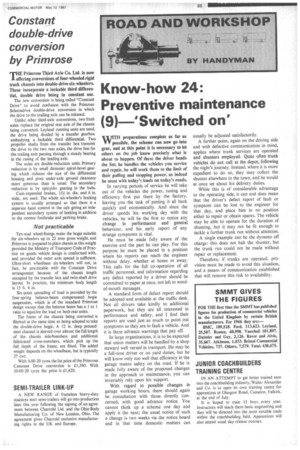Know-how 24: Preventive maintenance (9) 'Switched on'
Page 87

If you've noticed an error in this article please click here to report it so we can fix it.
preparations complete as far as Wrpossible, the scheme can now go into gear, and at this point it is necessary to let others on the job know precisely what is about to happen. Of these the driver heads the list; he handles the vehicles you service and repair, he will work them to the limit of their pulling and stopping power, as indeed he must with today's loads on today's roads.
In varying periods of service he will take out of the vehicles the power, tuning and efficiency first put there by the factory, leaving you the task of putting it all back quickly and economically. And since the driver spends his working day with the vehicles, he will be the first to notice any change in performance and general behaviour, and his early report of any strange symptoms is vital.
He must be made fully aware of the exercise and the part he can play. For this purpose he must be placed in a position where his reports can reach the engineer without delay, whether at home or away. This calls for the full co-operation of all traffic personnel, and information regarding any defect reported by a driver should be committed to paper at once, not left to wordof-mouth messages.
A standard form of defect report should be adopted and available at the traffic desk. Not all drivers take kindly to additional paperwork, but they are all interested in performance and safety, and I find their reports are used just as much to point out symptoms as they are to fault a vehicle. And it is these advance warnings that pay off.
In large organizations, it is to be expected that union matters will be handled by a shop steward well versed in transport. He may be a full-time driver or on yard duties, but he will know only too well that efficiency in the garage means safety on the road. If he is made fully aware of the proposed changes in the approach to maintenance, you can invariably rely upon his support.
With regard to possible changes in garage working hours, there should again be consultation with those directly concerned, with good advance notice. You cannot think up a scheme one day and apply it the next; the usual notice of such a change is two weeks via the notice board and in that time domestic matters can
usually be adjusted satisfactorily.
A further point, again on the driving side and with defective communication in mind, applies where trunk services are operated and shunters employed. Quite often trunk vehicles do not call at the depot, following the night's journey. Instead, where it is more expedient to do so, they may collect the shunter elsewhere in the town, and he would at once set about his deliVery duties.
While this is of considerable advantage to the operating side, it can and does mean that the driver's defect report of fault or symptom can be lost to the engineer for that day, and place him in no position either to repair or obtain spares. The vehicle may be able to operate for the duration of shunting, but it may not be fit enough to tackle a further trunk run without attention.
A single example can be the dynamo off charge: this does not halt the shunter, but the trunk run could not be made without repair or replacement.
Therefore, if trunks are operated, provision must be made to avoid this situation, and a means of communication established that will remove this risk to availability.
















































































































































































































































